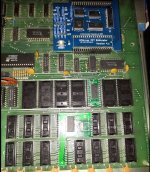Nivag Swerdna
Veteran Member
I have never used IEEE488 on my PET but am warming up to it... I thought I would like to test the functionality first at the PET end.
Specifically I would like to test the PIA#2, the VIA and the MC3446 devices.
Starting with data it seems the PIA#2 drives a pair of transceivers... is it possible to test writing to out and receiving on in? Do I need loopback hardware of some kind.
A pointer to any IEEE488 diagnostics would be appreciated
Thanks
Specifically I would like to test the PIA#2, the VIA and the MC3446 devices.
Starting with data it seems the PIA#2 drives a pair of transceivers... is it possible to test writing to out and receiving on in? Do I need loopback hardware of some kind.
A pointer to any IEEE488 diagnostics would be appreciated
Thanks


